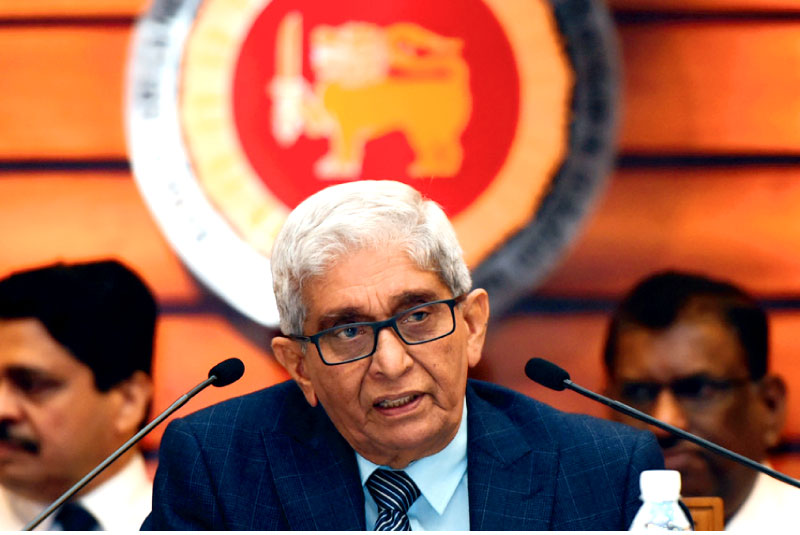Thursday Dec 04, 2025
Thursday Dec 04, 2025
Friday, 9 July 2021 02:57 - - {{hitsCtrl.values.hits}}

Central Bank Governor Prof. W. D. Lakshman
The Monetary Board has decided to keep policy rates unchanged at its meeting this week, a stance consistently maintained since the last revision in July 2020.
It said macroeconomic conditions and expected developments on the domestic and global fronts influenced its decision.
The Monetary Board was encouraged by the fact that the economy in the first quarter is likely to have recorded a higher than expected growth rate though the impact of the COVID third wave remains a concern. It noted that the external sector is expected to gradually recover in the period ahead.
It said as of end-June, excluding $ 1.5 billion SWAP with People’s Bank of China, the gross official reserves were estimated at $ 4 billion (equivalent to 2.7 months of imports).
It also observed market interest rates remain low, facilitating increased credit flows to the private sector.
The Monetary Board said any build-up of sustained inflationary pressures will be addressed through appropriate measures over the medium term.
Following is the full statement of the Central Bank.
Although GDP estimates for the first quarter of 2021 have not been released by the Department of Census and Statistics, indicators for several key sectors of the economy point towards a stronger than expected recovery during the quarter. Disturbances to domestic economic activity due to the third wave of the COVID-19 pandemic and related preventive measures weakened the recovery somewhat, in the second quarter of 2021.
Nevertheless, the ongoing vaccination drive throughout the country and the likely removal of mobility restrictions are expected to ease the impact of the current wave of COVID-19 on overall economic activity, thereby facilitating a sustained economic recovery towards achieving a GDP growth rate of around 5% in 2021.
Along with the expected recovery in the global economy and the improvements on the domestic front, the upward momentum of economic activity is envisaged to sustain over the medium term.
In spite of the resilience shown by merchandise exports, the trade deficit widened during the period from January to May, over the same period last year. Challenges emanating from multiple waves of COVID-19 globally and domestically continued to stifle the recovery of the tourism industry.
On the other hand, the notable improvement in workers’ remittances continued to provide support for the external current account.
While the measures introduced to address challenges in the external sector have helped ease the domestic foreign exchange market conditions to some extent, speculative behaviour and frontloading of imports have caused undue pressures in the market.
The exchange rate has recorded a depreciation of 6.7% against the dollar thus far during the year. As of end-June, the gross official reserves were estimated at $ 4 billion (equivalent to 2.7 months of imports). This does not include the bilateral currency swap facility with the People’s Bank of China (PBoC) of CNY 10 billion (equivalent to approximately $ 1.5 billion).
Although the level of foreign reserves could experience some variations in the period ahead, such developments are expected to be temporary, with the adequate financing strategies lined up to maintain reserves at sufficient levels and to meet all maturing debt servicing obligations of the Government on time.
In response to the monetary policy easing measures adopted by the Central Bank, most market deposit and lending interest rates have declined to their historic low levels. Prevailing low interest rates and the surplus rupee liquidity in the domestic money market enabled the flow of low-cost credit to the economy, thus supporting the revival of economic activity.
Accordingly, credit extended to the private sector expanded notably during the period from January to May, and this momentum is expected to sustain through 2021.
The Central Bank expects domestic investors to make use of the low interest rate environment to expand their productive economic activities and explore new opportunities that are being created in the economy aimed at local and international markets.
Credit obtained by the public sector from the banking system, particularly the Government, also increased notably, amidst the impact of the pandemic on government revenue and recurrent expenditure. With the significant expansion in domestic credit, the growth of broad money (M2b) remained elevated by end-May.
Inflation remains moderate, given the subdued aggregate demand conditions, although food inflation has accelerated due to supply-side disruptions. Inflation is expected to remain broadly within the desired 4-6% range during the remainder of 2021.
The envisaged improvements in aggregate demand conditions stemming from the effects of the stimulus measures adopted by the Central Bank and the Government and the likely increases in global commodity prices may generate some inflationary pressures over the medium term. Such pressures will be mitigated through timely policy intervention by the Central Bank, thereby ensuring the maintenance of inflation in mid-single digit levels over the medium term.
In consideration of the current and expected macroeconomic developments highlighted above, the Monetary Board decided to maintain the policy interest rates, i.e., Standing Deposit Facility Rate (SDFR) and the Standing Lending Facility Rate (SLFR) of the Central Bank, at their current levels of 4.50% and 5.50%, respectively.
The Central Bank will continue to monitor domestic and global macroeconomic and financial market developments and stand ready to take appropriate measures, as and when necessary, with the aim of maintaining inflation in the targeted 4-6% range under the flexible inflation targeting framework in the medium term, while supporting sustained economic recovery.